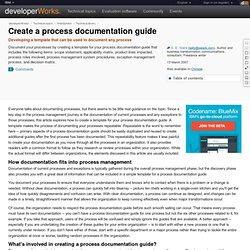

SIPOC Diagram. Kerri Simon February 26, 2010 Many recent inquiries and discussions have focused on the SIPOC diagram – a tool used in the Six Sigma methodology.

Because of the interest level, a further explanation is presented here along with a sample and template for your use. A SIPOC diagram is a tool used by a team to identify all relevant elements of a process improvement project before work begins. It helps define a complex project that may not be well scoped, and is typically employed at the Measure phase of the Six Sigma DMAIC (Define, Measure, Analyze, Improve, Control) methodology. It is similar and related to process mapping and ‘in/out of scope’ tools, but provides additional detail.
Chohmann.free.fr/5S/index_us.html. The 5S Essentials for readers in hurry Developed in Japan, this method assume no effective and quality job can be done without clean and safe environment and without behavioral rules. The 5S are five action verbs (Sort, Clean, Set in order, Standardize and Progress), all starting with an S in Japanese (Seiri, Seiton, Seiso, Seiketsu, Shitsuke). The name "Five S" now identify this method. The 5S allow to set up a well adapted and functional work environment, ruled by simple yet effective rules. 5S deployment is to be done in a logical and progressive way. Apparently simple, the 5S are a consistent and powerful set. 5S are the solid base, the foundation on which to build continuous improvement, install lean manufacturing tools and methods. 5S and 7 wastes according to Toyota.
Toyota developed its production system, striving for Excellence, with a keen sensitivity to waste. This quest for excellence gave birth to most of the "japanese" methods, among which the 5S approach. The seven types of waste are: 1. Waste from overproduction 2. Waste from waiting times 3. Read more about TPS For enterprises not yet in a state of excellence, wastes are opportunities of gain the 5S help to harvest.
It may sound surprizing, but many companies are producing more than necessary because they loose parts, products, material! It may lead to a double waste if the lost batch requires to produce a new one be delivered! Eliminating the wasted space and valuable surface by excess inventories and overproduction is another potential improvement. 5S can be used to setup rules for storing, define space and places. Www.grafo.co.za/downloads/brady_Lean_workplace_signage.pdf. What is a Process? Process Mapping 101 – Introductory Tutorial. Process Mapping is one of the quickest and most intuitive ways to document all sorts of different activities that go on inside your business every day.
For initiatives like regulatory compliance to process improvement to education and training, you may find that Process Maps are the quickest and most effective way to document and communicate how your business works. With just a few clicks of the mouse, you can illustrate what otherwise would be complicated to write as well as tedious and time consuming to read in narrative form. Before getting started, it is a good idea to familiarize yourself with the Process Modeler Environment and check out the Process Modeler Quick Start . These two articles will give you a basic understanding of what the Process Modeler can do.
An Introduction to Operations Management. VOC. Voice of Customers Very few organisations truly understand what their customers want in the way of service or product quality.

Even less could tell you how well they are performing to the specific requirements their customers have. Many people fall into the trap of assuming based on their experience what their customer. To truly understand, you have to ask and clarify continually. Your customers’ wants and needs are every changing. The better you deliver against customer requirements the higher the customer satisfaction. Voice of the Customer The customer is any person or group that receives your product or service and they have specific expectations of what they want. Voice of the customer (VOC) is the expectations of the customers, expressed by them, explicitly or implicitly.
Create a process documentation guide. Everyone talks about documenting processes, but there seems to be little real guidance on the topic.

Since a key step in the process management journey is the documentation of current processes and any exceptions to those processes, this article explores how to create a template for your process documentation guide. A template makes the process of documenting your processes repeatable. Repeatable is the word to remember here -- primary aspects of a process documentation guide should be easily duplicated and reused to create additional guides after the first process has been documented. This repeatability feature makes it less painful to create your documentation as you move through all the processes in an organization. It also provides readers with a common format to follow as they research or review processes within your organization. How documentation fits into process management What's involved in creating a process documentation guide? Create a scope statement Figure 1. Summary.